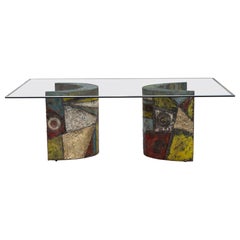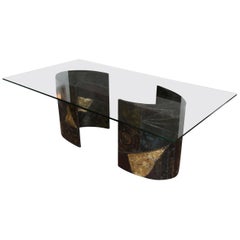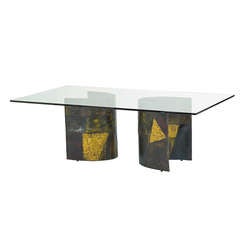Paul Evans Pe24
Vintage 1960s American Mid-Century Modern Dining Room Tables
Brass, Bronze, Steel
Recent Sales
Mid-20th Century American Mid-Century Modern Dining Room Tables
Vintage 1970s American Mid-Century Modern Dining Room Tables
Steel, Bronze
Vintage 1960s American Mid-Century Modern Dining Room Tables
Brass, Bronze, Steel
Vintage 1970s American Brutalist Dining Room Tables
Steel
Vintage 1970s North American Mid-Century Modern Dining Room Sets
Vintage 1960s American Dining Room Tables
Steel
Vintage 1970s American Mid-Century Modern Dining Room Tables
Steel
People Also Browsed
Antique Early 1900s French Chinoiserie Armchairs
Velvet, Giltwood, Lacquer
Mid-20th Century Italian Mid-Century Modern Dining Room Chairs
Leather
Mid-20th Century Swedish Mid-Century Modern Night Stands
Walnut
Vintage 1950s Italian Mid-Century Modern Armchairs
Metal, Brass
Vintage 1920s Dutch Art Deco Table Lamps
Copper
Antique 19th Century American Paintings
Canvas, Giltwood, Paint
2010s British Futurist Dining Room Tables
Aluminum
Vintage 1970s American Modern Commodes and Chests of Drawers
Brass, Chrome
21st Century and Contemporary American Side Tables
Aluminum
Vintage 1970s European Mid-Century Modern Table Lamps
Chrome, Metal
Vintage 1970s Italian Mid-Century Modern Chairs
Leather
2010s American Brutalist Chairs
Concrete
20th Century American Mid-Century Modern Coffee and Cocktail Tables
Brass
Antique 1880s English Victorian Lounge Chairs
Hardwood
Vintage 1970s American Post-Modern Side Tables
Brass, Steel, Chrome
2010s French Modern Coffee and Cocktail Tables
Stone, Steel
Paul Evans Pe24 For Sale on 1stDibs
How Much is a Paul Evans Pe24?
Paul Evans for sale on 1stDibs
A designer and sculptor, Paul Evans was a wild card of late 20th century modernism. A leading light of the American Studio Furniture movement, Evans’s sideboards, credenzas, coffee tables and other work manifests a singular aesthetic sense, as well as a seemingly contradictory appreciation for both folk art forms and for new materials and technologies.
Evans’s primary material was metal, not wood, which was favored by his fellow studio designers, and Bucks County, Pennsylvania, neighbors George Nakashima and Phillip Lloyd Powell. He trained in metallurgy and studied at the Cranbrook Academy of Art, the famed crucible of modern design and art in suburban Detroit. For a time early in his career, Evans also worked at Sturbridge Village, a historical “living museum” in Massachusetts, where he gave demonstrations as a costumed silversmith.
Evans’s earliest work unites these influences. The pieces that made his reputation are known as “sculpted-front” cabinets: wood cases faced with box-like high-relief patinated steel mounts laid out in a grid pattern. Each mount contains a metal emblem, or glyph, and the effect is that of a brawny quilt.
Evans’s later work falls into three distinct style groups. His sculpted-bronze pieces, begun in the mid-1960s, show Evans at his most expressive. He employed a technique in which resin is hand-shaped, and later sprayed with a metal coating, allowing for artistic nuance in the making of chairs, tables and case pieces. Later in the decade and into the 1970s, Evans produced his Argente series for celebrated manufacturer Directional (a brand known to vintage mid-century modern furniture collectors everywhere): consoles and other furniture forms that feature aluminum and pigment-infused metal surfaces welded into abstract organic forms and patterns.
Last, Evans's Cityscape design series — a milestone in the history of brutalist design — meshed perfectly with the sleek, “high tech” sensibility of the later ’70s. Evans constructed boxy forms and faced them with irregular mosaic patterns that mixed rectangular plaques of chromed steel, bronze or burlwood veneer. These, like all of Paul Evans’s designs, are both useful and eye-catching. But their appeal has another, more visceral quality: these pieces have clearly been touched by an artist’s hand.
Find a collection of authentic Paul Evans furniture today on 1stDibs.
Finding the Right Dining-room-tables for You
No matter your furniture style of choice, a shared meal is one of life’s true rewards. Why not treat your family and friends to a luxurious dining experience? Browse our top picks to find the perfect antique, new or vintage dining room table for this important occasion.
Modern furniture design borrows significantly from the trends of yore, and this is especially apparent in dining tables. Ancient Egyptians made practical use of the earliest four-legged tables of wood and rock — their models bear striking similarity to the dining tables of today — while common large medieval dining room tables in England were made of oak or elm. Romans and Greeks, renowned for big banquets that involved entertainment as well as good food, used early dining room tables made of marble or wood and metals such as bronze for meals.
On 1stDibs, find a range of dining room tables that offers no shortage of options to accommodate modest interiors, midsize family homes and even lavish banquets (entertainment not included).
Beginning in the mid-19th century, more American homes featured dining rooms, where families could gather specifically for a meal together. In the States, upper-class families were the first to enjoy dining room tables, which were the centerpiece of the dining room.
Dining room tables of the Victorian era were created in a range of revivalist styles inspired by neoclassical, Renaissance, Gothic and other traditions. Furnishings of the period were made of various woods, including oak, rosewood and mahogany, and referenced a variety of decorative arts and architectural motifs. Some dining room tables finished in the Rococo style feature gorgeous inlaid marble tabletops or other ornamental flourishes handcrafted by Parisian furniture makers of the 18th century.
In many modern spaces, there often isn’t a dining room separate from the kitchen — instead, they frequently share real estate in a single area. Mid-century modern dining room tables, specifically those created by designers such as Osvaldo Borsani, Edward Wormley and Alvar Aalto, are typically clean and uncomplicated designs for a dining area that’s adjacent to where the cooking is done. Furniture of this era hasn’t lost its allure for those who opt for a casual and contemporary aesthetic.
If you’re of the modern mindset that making and sharing meals should be one in the same — and perhaps large antique dining tables don’t mesh well with your style — consider a popular alternative. Working with a tighter space may mean that a round or oval dining room table, a design that references the festive meals of the medieval era, may be a better fit. Round dining room tables, particularly those that originated in the Art Deco period, still endure as a popular contemporary substitute for traditional rectangular dining tables. Giovanni Offredi’s Paracarro table for Saporiti Italia is a striking round table option that showcases the magnificent Italian industrial design of the 1970s.
Find a collection of antique, new and vintage dining tables on 1stDibs.


